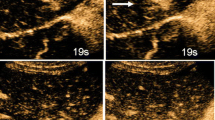Abstracts
Objective
To correlate contrast-enhanced ultrasound (CEUS) findings of hepatic focal nodular hyperplasia (FNH) with lesion size, depth and liver echogenicity and to compare CEUS with baseline US.
Methods
Two radiologists evaluated baseline US and CEUS examinations of 92 FNHs (mean size: 3.1 ± 1.7 cm) in 71 patients (59 women and 12 men) to detect the “spoke-wheel” sign, central scar and feeding vessel. The FNHs were grouped and analysed by dimension, depth and liver echogenicity.
Results
At least one sign could be detected at CEUS in 27 out of 36 (75%) FNHs larger than 3 cm and in 17 out of 56 (30%) FNH measuring 3 cm or less (p < 0.0001). No statistically significant differences were noted between lesion depth or liver echogenicity and detection rate of these signs at CEUS (p > 0.05) as well as between CEUS or baseline US/CD with regard to lesion size, depth or liver echogenicity (p > 0.05).
Conclusion
The detection rate of the central scar and spoke-wheel sign in FNH at CEUS is strongly dependent on lesion size and CEUS can confidently diagnose most FNHs larger than 3 cm.



Similar content being viewed by others
References
Vilgrain V (2006) Focal nodular hyperplasia. Eur J Radiol 58:236–245
Ros PR, Menu Y, Vilgrain V et al (2001) Liver neoplasms and tumor-like conditions. Eur Radiol 11(Suppl 2):S145–S165
Harvey CJ, Albrecht T (2001) Ultrasound of focal liver lesions. Eur Radiol 11:1578–1593
Bartolotta TV, Taibbi A, Midiri M, Lagalla R (2009) Focal liver lesions: contrast-enhanced ultrasound. Abdom Imaging 34:193–209
Quaia E (2007) Microbubble ultrasound contrast agents: an update. Eur Radiol 17:1995–2008
Quaia E, Calliada F, Bertolotto M et al (2004) Characterization of focal liver lesions with contrast-specific US modes and sulphur hexafluoride-filled microbubble contrast agent: diagnostic performance and confidence. Radiology 232:420–430
Catala V, Nicolau C, Vilana R et al (2007) Characterization of focal liver lesions: comparative study of contrast-enhanced ultrasound versus spiral computed tomography. Eur Radiol 17:1066–1073
Quaia E, D’Onofrio M, Palumbo A, Rossi S, Bruni S, Cova M (2006) Comparison of contrast-enhanced ultrasonography versus baseline ultrasound and contrast-enhanced computed tomography in metastatic disease of the liver: diagnostic performance and confidence. Eur Radiol 16:1599–1609
Kim TK, Jang HJ, Burns PN, Murphy-Lavallee J, Wilson SR (2008) Focal nodular hyperplasia and hepatic adenoma: differentiation with low-mechanical-index contrast-enhanced sonography. AJR Am J Roentgenol 190:58–66
Ungermann L, Eliás P, Zizka J, Ryska P, Klzo L (2007) Focal nodular hyperplasia: spoke-wheel arterial pattern and other signs on dynamic contrast-enhanced ultrasonography. Eur J Radiol 63:290–294
Bartolotta TV, Midiri M, Scialpi M, Sciarrino E, Galia M, Lagalla R (2004) Focal nodular hyperplasia in normal and fatty liver: a qualitative and quantitative evaluation with contrast-enhanced ultrasound. Eur Radiol 14:583–591
Lin LW, Yang JJ, Lin XY et al (2007) Effect of fatty liver background on contrast-enhanced ultrasonographic appearance of focal nodular hyperplasia. Hepatobiliary Pancreat Dis Int 6:610–615
Bartolotta TV, Taibbi A, Galia M, Runza G, Matranga D, Midiri M, Lagalla R (2007) Characterization of hypoechoic focal hepatic lesions in patients with fatty liver: diagnostic performance and confidence of contrast-enhanced ultrasound. Eur Radiol 17:650–661
Hussain SH, Terkivatan T, Zondervan PE et al (2004) Focal nodular hyperplasia: findings at state-of-the-art MR imaging, US, CT, and pathologic analysis. Radiographics 24:3–19
Brancatelli G, Federle MP, Grazioli L et al (2001) Focal nodular hyperplasia: CT findings with emphasis on multiphasic helical CT in 78 patients. Radiology 219:61–68
Grazioli L, Morana G, Kirchin MA, Schneider G (2005) Accurate differentiation of focal nodular hyperplasia from hepatic adenoma at gadobenate dimeglumine-enhanced MR imaging: prospective study. Radiology 236:166–177
Yen YH, Wang JH, Lu SN et al (2006) Contrast-enhanced ultrasonographic spoke-wheel sign in hepatic focal nodular hyperplasia. Eur J Radiol 60:439–444
von Herbay A, Westendorff J, Gregor M (2009) Contrast-enhanced ultrasound with SonoVue: Differentiation between benign and malignant focal liver lesions in 317 patients. J Clin Ultrasound 38:1–9
Strobel D, Seitz K, Blank W et al (2009) Tumor-specific vascularization pattern of liver metastasis, hepatocellular carcinoma, hemangioma and focal nodular hyperplasia in the differential diagnosis of 1,349 liver lesions in contrast-enhanced ultrasound (CEUS). Ultraschall Med 30:376–82
Ding H, Wang WP, Huang BJ, Wei RX, He NA, Qi Q, Li CL (2005) Imaging of focal liver lesions: low-mechanical-index real-time ultrasonography with SonoVue. J Ultrasound Med 24:285–297
Xu HX, Liu GJ, Lu MD et al (2006) Characterization of focal liver lesions using contrast-enhanced sonography with a low mechanical index mode and a sulfur hexafluoride-filled microbubble contrast agent. J Clin Ultrasound 34:261–272
Strobel D, Seitz K, Blank W et al (2008) Contrast-enhanced ultrasound for the characterization of focal liver lesions—diagnostic accuracy in clinical practice (DEGUM multicenter trial). Ultraschall Med 29:499–505
Nicolau C, Vilana R, Catalá V et al (2006) Importance of evaluating all vascular phases on contrast-enhanced sonography in the differentiation of benign from malignant focal liver lesions. AJR Am J Roentgenol 186:158–167
Wilson SR, Jang HJ, Kim TK, Iijima H, Kamiyama N, Burns PN (2008) Real-time temporal maximum-intensity-projection imaging of hepatic lesions with contrast-enhanced sonography. AJR Am J Roentgenol 190:691–695
Author information
Authors and Affiliations
Corresponding author
Rights and permissions
About this article
Cite this article
Bartolotta, T.V., Taibbi, A., Matranga, D. et al. Hepatic focal nodular hyperplasia: contrast-enhanced ultrasound findings with emphasis on lesion size, depth and liver echogenicity. Eur Radiol 20, 2248–2256 (2010). https://doi.org/10.1007/s00330-010-1775-x
Received:
Revised:
Accepted:
Published:
Issue Date:
DOI: https://doi.org/10.1007/s00330-010-1775-x




